@Capp777, first allow me the privilege to say — you were right from the very beginning. PID 221685 on my ’04 F150 5.4 Triton IS IN FACT Cylinder Head Temperature (alt) – just like Torque Pro labels it and like you said in your first reply.
As often happens, a clue was staring me in the face. The screenshot in my second post shows CHTMP [241.9 ºF] and CHTMP(alt) [12,720 ºF] and both are setting at approximately the same percentage scale.!!! (although overall CHTMP(alt) never made sense).
Capp777’s FIRST response to my post was largely dead on correct about being a voltage representation — but I learned the Cyl Head Temp is a sophisticated DUAL thermister type sensor (both hot & cold range sensors) with only two conductors and one common ground via the Cyl head. The PCM uses a complex algorithm to determine Cyl Head Temp – and from that extrapolate coolant temp. The 5.4L Triton engine has no coolant temp sensor. The PCM outputs an ECT PID, and two PID’s, 221624 and 221685 for CHT, all from this single sensor. A very informative article on FORD CYL HEAD TEMP SENSORS exists at http://www.searchautoparts.com/motorage/powertrain-pro/diagnosing-fords-cylinder-head-temperature-cht-sensor
The standard Torque formula for PID 221624 (CHTMP) (((A*256)+B)*1.999)+32 displays ºF perfectly. IMHO the “+32” should be there, likely for ºC to ºF offset. Also I believe CHTMP *should* be somewhat higher than my coolant temp.
HOWEVER, sorting out PID 221685 — has been a different story and almost drove me NUTS before finding the article in the above link. As it turns out – Capp777 was dead on correct again – with _minor_ adjustments. WHAT the PCM is doing with PID 221685 is fascinating to say the least. In trying to sort it out, I Analyzed the pure untouched output of PID 221685 [by using the simple formula (A*256)+B], and converted that value to 16 bit base 2 using Excel.
WHAT I FOUND WAS FACINATING – INTERESTING – and clever. The 16 bit word consisting of bytes “A” and “B” is broken into two very odd sized nibbles. The LSB 6 bits are a signed value of +32 to -32 (total of 64). The next 9 most significant bits are a non-signed value between 0 to 512. These two nibbles independently, synchronously, and uniformly track the temperature. The MSB is a switch (I think 1 indicates the LSB 15 bits is voltage for “hot” range circuit, and 0 indicates the voltage reading represents the “cold” range circuit – see the linked article), but that’s not important here.
What is important is at FULL EOT the high order bit is always ON, and if the two weird size nibbles are viewed purely as a 16 bit “word” value, applying the formula Capp777 provided for 0-5v conversion, [ ((A*256)+B)/13168 ], and the result is displayed on a 0-5 volt gauge in Torque, it tracks CHTMP.
On a cold soak startup, the PCM goes through an apparent “calibration” procedure that takes about 10 minutes during engine warm-up. (This action can somewhat be seen in my previous Excel Screenshot) These two nibbles, each independently, but synchronously, perform a binary count down – starting from value at the end of last drive cycle, counting down to binary Zero — that (not so surprisingly) represents .5 volts (which would be the voltage drop across a silicon junction in the PCM substrate where it would cease conducting current). Also the count of 256 in the upper nibble (with a zero in the lower nibble) equates to exactly 2.5 volts. What is interesting (and clever) about this is – when you view the whole word “A and B” as a binary value (where the lower 6 bits ranges from -31 to +32) as a integral part of that whole word, it creates a perfect “S” curve in the value being output by the PCM. Thus the PCM is taking care of the “S” curve calculations and making the output a pure clean 0-5v signal for the external reader. I thought that was kind of a slick way to do it.
But, now I do not know the proper PID for my “Intake Charge Motion Control Valve”, which is what I thought 221685 was.!!! I’ve tested the 221684 that Capp777 suggested, but it returns “NO RESPONSE”. ????? There is a DTC for “IMCV stuck OPEN” and “IMCV stuck CLOSED”. Does Anyone know what PID would read the condition or position of the IMCV on a Ford 5.4L engine?
Thanks for help.
—————
54371019
|

 Author
Author
 Cylinder head temperature(alt) [221685] What is it?
Cylinder head temperature(alt) [221685] What is it?
%201.jpg)


